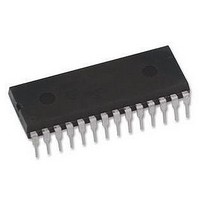ATMEGA168PA-PU Atmel, ATMEGA168PA-PU Datasheet - Page 12

ATMEGA168PA-PU
Manufacturer Part Number
ATMEGA168PA-PU
Description
MCU, 8BIT, AVR, 16K FLASH, 28PDIP
Manufacturer
Atmel
Datasheet
1.ATMEGA48A-PU.pdf
(566 pages)
Specifications of ATMEGA168PA-PU
Controller Family/series
Atmega
No. Of I/o's
23
Eeprom Memory Size
512Byte
Ram Memory Size
1KB
Cpu Speed
20MHz
No.
RoHS Compliant
Core Size
8bit
Program Memory Size
16KB
Oscillator Type
External, Internal
Rohs Compliant
Yes
Available stocks
Company
Part Number
Manufacturer
Quantity
Price
Company:
Part Number:
ATMEGA168PA-PU
Manufacturer:
TI
Quantity:
1 240
- Current page: 12 of 566
- Download datasheet (23Mb)
6.4.1
6.5
8271C–AVR–08/10
Stack Pointer
The X-register, Y-register, and Z-register
The registers R26...R31 have some added functions to their general purpose usage. These reg-
isters are 16-bit address pointers for indirect addressing of the data space. The three indirect
address registers X, Y, and Z are defined as described in
Figure 6-3.
In the different addressing modes these address registers have functions as fixed displacement,
automatic increment, and automatic decrement (see the instruction set reference for details).
The Stack is mainly used for storing temporary data, for storing local variables and for storing
return addresses after interrupts and subroutine calls. Note that the Stack is implemented as
growing from higher to lower memory locations. The Stack Pointer Register always points to the
top of the Stack. The Stack Pointer points to the data SRAM Stack area where the Subroutine
and Interrupt Stacks are located. A Stack PUSH command will decrease the Stack Pointer.
The Stack in the data SRAM must be defined by the program before any subroutine calls are
executed or interrupts are enabled. Initial Stack Pointer value equals the last address of the
internal SRAM and the Stack Pointer must be set to point above start of the SRAM, see
3 on page
See
Table 6-1.
The AVR Stack Pointer is implemented as two 8-bit registers in the I/O space. The number of
bits actually used is implementation dependent. Note that the data space in some implementa-
tions of the AVR architecture is so small that only SPL is needed. In this case, the SPH Register
will not be present.
ATmega48A/48PA/88A/88PA/168A/168PA/328/328
X-register
Y-register
Z-register
Instruction
PUSH
CALL
ICALL
RCALL
POP
RET
RETI
Table 6-1
18.
The X-, Y-, and Z-registers
Stack Pointer instructions
Stack pointer
Decremented by 1
Decremented by 2
Incremented by 1
Incremented by 2
for Stack Pointer details.
15
7
R27 (0x1B)
15
7
R29 (0x1D)
15
7
R31 (0x1F)
Description
Data is pushed onto the stack
Return address is pushed onto the stack with a subroutine call or
interrupt
Data is popped from the stack
Return address is popped from the stack with return from
subroutine or return from interrupt
XH
YH
ZH
0
0
0
7
R26 (0x1A)
7
R28 (0x1C)
7
R30 (0x1E)
Figure
6-3.
XL
YL
ZL
0
0
0
0
0
0
Table 7-
12
Related parts for ATMEGA168PA-PU
Image
Part Number
Description
Manufacturer
Datasheet
Request
R

Part Number:
Description:
Manufacturer:
Atmel Corporation
Datasheet:

Part Number:
Description:
Manufacturer:
Atmel Corporation
Datasheet:

Part Number:
Description:
Manufacturer:
ATMEL Corporation
Datasheet:

Part Number:
Description:
IC AVR MCU 16K 20MHZ 32TQFP
Manufacturer:
Atmel
Datasheet:

Part Number:
Description:
IC AVR MCU 16K 20MHZ 32-QFN
Manufacturer:
Atmel
Datasheet:

Part Number:
Description:
IC AVR MCU 16K 20MHZ 28DIP
Manufacturer:
Atmel
Datasheet:

Part Number:
Description:
MCU AVR 16K FLASH 15MHZ 32-TQFP
Manufacturer:
Atmel
Datasheet:

Part Number:
Description:
MCU AVR 16K FLASH 15MHZ 32-QFN
Manufacturer:
Atmel
Datasheet:

Part Number:
Description:
IC AVR MCU 16K 20MHZ 32TQFP
Manufacturer:
Atmel
Datasheet:

Part Number:
Description:
MCU AVR 16KB FLASH 20MHZ 32QFN
Manufacturer:
Atmel
Datasheet:

Part Number:
Description:
MCU AVR 16KB FLASH 20MHZ 32TQFP
Manufacturer:
Atmel
Datasheet:

Part Number:
Description:
IC MCU AVR 16K FLASH 32-QFN
Manufacturer:
Atmel
Datasheet:











